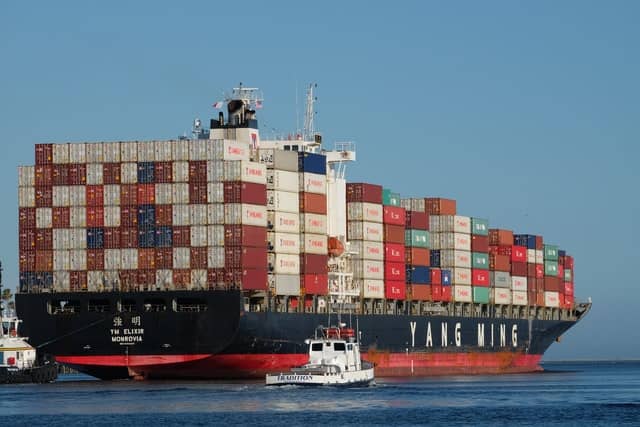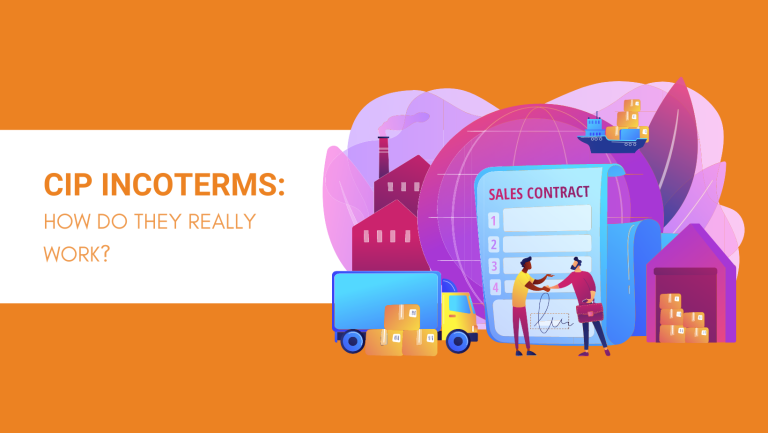Incoterms are defined as International Commercial Terms and are also informally known as shipping terms. They outline the responsibilities of different parties during the transfer of goods from a seller to a buyer.
CIP is one of the 11 internationally recognized shipping Incoterms. Like all the others, it has distinct rules and provisions and it is important to understand them before agreeing to use CIP as your preferred Incoterm.
So, before you sign that sales contract with your supplier, here is a comprehensive guide to CIP Incoterms. In it, we share how CIP works, its pros and cons, as well as some insights on when it is ideal to use it.

CIP Incoterms Meaning
CIP is an abbreviation for ‘Carriage and Insurance Paid’.
It is a shipping Incoterm where the seller is obliged to pay for transportation of the goods from their premises to a specific destination agreed upon with the buyer.
Additionally, the seller should also pay for insurance to cover the goods against risk until they arrive at the stated destination.
Based on this, CIP is usually expressed in relation to a destination. Take, for example, that your supplier is shipping your order of wholesale toys from Chenghai in China to Sydney, Australia. The shipping documents for such a shipment would read, ‘CIP Sydney’.
Understanding the Responsibilities of a Seller and a Buyer in CIP Incoterms
As we mentioned in the beginning, Incoterms outline the risk, tasks, and costs that a seller and a buyer are responsible for during the shipping of goods. So, let’s take a look at how the responsibilities play out in CIP shipping.

The Seller’s Responsibilities
The seller is responsible for:
- Preparing and packing the goods as per your order
- Loading the goods and delivering them to the agreed mode of shipping transport. It could be a ship, a train, or even a plane.
- Clearing the goods for exports with all the relevant documentation
- Paying export clearance fees, freight charges, and insurance coverage to the agreed destination
Note: The current CIP terms are that the seller should pay at least 110% of the value of the contract as insurance coverage.
- Providing the buyer with all the documents they will need to claim the goods once they arrive at their port and a tracking number for the shipment.
Once the seller delivers the goods to the carrier the responsibility of the goods shifts to the buyer. If there will be more than one carrier, the seller’s responsibility ends at the first carrier.
This means that it is up to the buyer to keep track of the shipment until it arrives and handle all other processes from then on.
The Buyer’s Responsibilities
As the buyer, you would be responsible for:
- Keeping track of the goods until they arrive at the agreed destination
- The cost of unloading the goods
- Clearing the goods through customs
- Paying any import duties or taxes that may arise
- Organizing delivery of the goods to your warehouse or any other location that you prefer
Tracking a CIP shipment is no different from any other kind of cargo tracking. You only need your supplier to share with you the tracking number once they have cleared the goods for shipping on their end.
When Should You Use CIP Incoterms?
When You Need Flexibility in Transport Options

CIP Incoterms can be applied for goods being shipped by sea, inland waterways, rail, or air. So, in terms of transport flexibility, CIP Incoterms are ideal because they would not restrict you to one mode of transport.
When You Are Using a Letter of Credit
A letter of credit is a document that assures your supplier that they will receive payment once they have supplied the goods to you and fulfilled the conditions specified in the sales agreement.

CIP Incoterms work well for this kind of arrangement because:
- Once the supplier delivers the goods to the carrier, they can claim a bill of lading or an onboard notation which they can present to the bank as proof of delivery and then claim payment.
- The fact that the goods are insured provides assurance that even if the goods get damaged in transit, you will still be compensated and the sum that was paid to the supplier will not count as a loss.
In the current Incoterms 2020, you (the buyer) are required to instruct the carrier to provide your supplier with a bill of lading and an onboard notation after they deliver the goods.
This is because, previously, if the cargo is not shipped on time or gets damaged at the carrier’s premises, a seller would not be able to claim a bill of lading. They, subsequently, would not be able to pursue payment with the bank.
Giving sellers the relevant documents upon delivery saves them the trouble of dealing with such liabilities. It also makes them more open to accepting orders on the strength of a Letter of Credit.
How Do CIP Incoterms Compare to Other Similar Incoterms?
CIP Incoterms are partially similar to CPT and CIF Incoterms. As such, most entrepreneurs often confuse them and feel torn between them. Let us compare them against each other for better clarity.

CIP vs CPT
In Carriage and Insurance Paid (CIP), the seller caters for the cost of insuring and shipping the goods from their premises to a destination agreed upon with the seller.
Meanwhile, in Carriage Paid To (CPT) the seller only pays for the costs of transporting the goods.
In brief, the main difference between the two is that in CIP the seller pays for both insurance and transport. If you opt for CPT, you (the buyer) would have to incur the cost of insuring the goods.
Naturally, CIP offers more of an advantage because you would not have to organize the insurance bit. CPT may only be a better choice if you prefer or are mandated by your letter of credit to use specific insurance providers.
CIP vs CIF
CIF stands for ‘Cost, Insurance, and Freight’. It is similar to CIP because in both cases the seller is responsible for paying for the transportation and insurance of the goods to a specific destination.
However, CIF is only restricted to sea or ocean freight. Therefore:
- The buyer can not use more than one mode of transport under CIF Incoterms.
- The seller only pays for shipping insurance in accordance with marine policy.
In contrast, CIP applies to all means of cargo shipping. As a result:
- A buyer can use more than one mode of transport.
- The seller is obliged to pay for insurance of the goods for both carriers until the goods arrive at the agreed destination.
In light of this, CIF is ideal when shipping via sea/ocean, and delivery is only required up to the port of destination. CIP, on the other hand, is suitable for situations where more than one carrier is necessary as is the case in door-to-door shipping arrangements.
Quick tip: door-to-door shipping is where the seller agrees to cater for shipping from their warehouse door to your warehouse door.
Advantages and Disadvantages of CIP Incoterms

Advantages
- The seller handles all the processes of organizing transport, export clearances, and shipping insurance in their country which you may not be familiar with.
- CIP offers flexibility in terms of transport and so even if sea shipping is overwhelmed during peak seasons, like Q4 dropshipping season, you can turn to alternatives like air or rail.
- The revised CIP Incoterms provide a more efficient way for sellers to acquire the relevant documents from carriers after they deliver the goods to them.
Disadvantages
- CIP premiums are often higher, especially where there is more than one carrier involved and the seller may have to pass this expense to the buyer.
- While it is the seller that bears the burden of arranging insurance coverage, it is always the buyer that has to follow up for compensation if anything goes wrong. The seller’s responsibility ends when the carrier receives the cargo.
FAQs on CIP Incoterms
Who Pays Duty in CIP?
Export duty is paid in full by the seller as they are dispatching the goods at the port of origin. The buyer, on the other hand, pays all import duties when the goods arrive at the port of destination.
What Factors of CIP Incoterms Are Negotiable?
Under the CIP Incoterm rules, you and your seller can negotiate:
- The level of insurance coverage– your seller can either cover the goods against all risks or at least 110% of the value of the supply contract. Both are fair terms but you can negotiate between them based on the type of risk you anticipate.
- The extent of delivery- CIP rules state that a seller should deliver to a set destination; this can be a port, a freight station, or your warehouse. It all depends on what you and your seller negotiate and agree on.
- Unloading costs- you and your seller can decide which one of you is to pay for the unloading costs once the goods arrive at the port of destination or your warehouse.
What Factors Should I Consider When Agreeing to CIP Incoterms?
Consider:
- The value of the goods- CIP has a higher insurance stipulation (110%) compared to other options like CIF. It is thus better to ship higher value goods under CIP Intercoms because you get more protection against loss or damage.
- The insurer- it is important to do due diligence on the insurance provider that your seller chooses to use. They should be of good standing and be able to settle a claim in your country without undue delays.
- The terms of your Letter of Credit- letters of credit usually specify details such as what mode of transport should be used and what insurers or insurance coverage is acceptable. It is best to ensure that your CIP shipping adheres to their terms.
In Summary
CIP Incoterms can be a great advantage when applied in the right circumstances. So, take time to compare the shipping needs of your business against what you have learned here and see if CIP is the right fit for you.
If all the shipping jargon seems complex or you are having a hard time negotiating Incoterms with your supplier, we can help.
We, at NicheSources, are more accomodating. We can source products for you and offer you multiple shipping options to choose from.
To get started, send us a list of your sourcing and shipping requirements and request a free quote.

